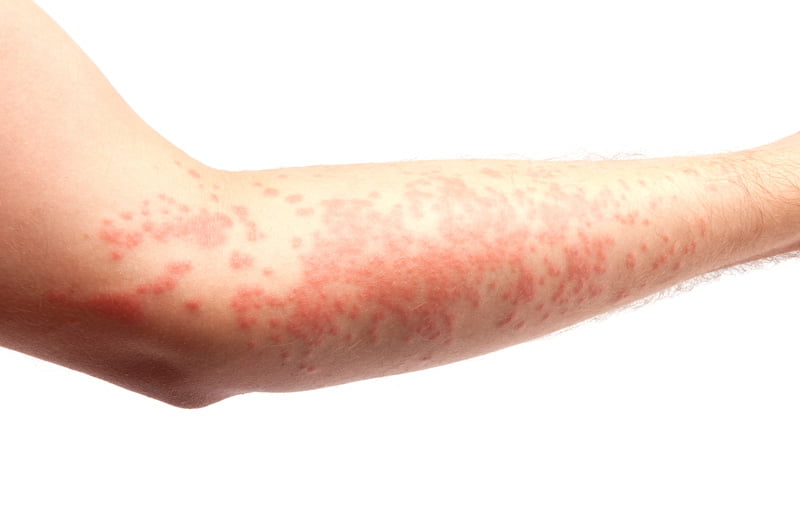What is an Adverse Drug Reaction?
An Adverse Drug Reaction (ADR) is an undesirable side-effect caused by consuming drugs/medication. ADRs may result from a single dose or prolonged administration of a medication. They may also occur due to the combination of ingesting two or more drugs. Adverse Drug Reactions may affect one or more internal organs as well as the skin. ADRs of the skin may be mild or severe, and can present with a rash or blisters that may also affect the mucosal membranes. These reactions may rarely be life-threatening, hence the importance of early recognition and withdrawal of the offending drug.
An Adverse Drug Reaction is differentiated from an Adverse Drug Event (ADE) in that an ADE refers to any harm that occurs while the patient is ingesting a drug or drug, irrespective of whether the drug(s) itself is the cause of the harm.
ADRs are typically classified into two types:
1. Type A reactions (Augmented reactions) – These are dose-dependant reactions and constitute approximately 80% of ADRs. They are usually the consequence of the pharmacology of the drug and therefore predictable. Severity of these can range from mild to very severe and even fatal.
2. Type B reactions (Idiosyncratic) – These reactions are unpredictable on the basis of pharmacology of the drug. These reactions often occur with the introduction of new drugs whose effects have not been fully tested for all possible range of side-effects and therefore not understood by the pharmacological or health industry.

Skin-related Symptoms of an Adverse Drug Reaction
Adverse Cutaneous Drug Reactions are ADRs that affect the structure or function of the skin, its appendages, or mucous membranes. The reactions range from mild to severe and from localised just to the skin to those associated with systemic disease that affects other organs. Cutaneous Drug Reactions are the most common ADRs that occur, and here is a list of the most common Adverse Cutaneous Drug Reactions and their symptoms:
| Type of Cutaneous Adverse Drug Reaction | Symptoms on Skin |
|---|---|
| Angioedema | A deep, skin-coloured swelling, most commonly of the lips or eyes, that may last for several days |
| DRESS (Drug Reaction with Eosinophilia and Systemic Symptoms) | It is a severe Type B (idiosyncratic) drug reaction and has a long latency period. Symptoms may not appear for several weeks after initially ingesting the drug. Various symptoms appear including urticaria, maculopapular, purpura, pustules etc. It is accompanied by high fever and symptoms that mimic viral hepatitis. Probability of mortality with this reaction is high. |
| Erythema Multiforme | Symptoms vary with condition from a mild rash with raised papules in a localised area that starts from hands or feet and spreads over the limbs. Rashes often appear to have a “bulls-eye”, with a dark red centre that may have a blister or crust, surrounded by a pale pink ring and a darker outermost ring. In more severe conditions, rashes may combine to form large patches of red that may be painful. |
| Maculopapular Rash | Characterised by a combination of both flat and raised skin lesions with a pattern of macules and papules. It is identifiable as a red bump on the skin surrounded by a flat red patch |
| Morbilliform Rash | Appearance is similar to that of measles. It consists of macular lesions or flat red lesions on skin. |
| Stevens-Johnson Syndrome | It is a type of severe ADR and often begins with flu-like symptoms, followed by a painful red or purplish rash that spreads and blisters. The blisters begin to peel forming raw, painful areas on the skin. Mucous membranes such as the mouth are also affected. Other symptoms include dehydration, sepsis, pneumonia and even multiple organ failure. |
| Toxic Epidermal Necrolysis | A similar but more severe ADR than Stevens-Johnson Syndrome. Early symptoms also include fever and flu-like symptoms which are followed by painful blisters that peel and form raw areas on skin. Mucous membranes are also affected. Other symptoms include dehydration, sepsis, pneumonia and even multiple organ failure. More than 30% of the total skin surface of the body may be affected. |
| Urticaria | A rash with raised, itchy bumps on the skin. |
Assessment and Treatment for Adverse Drug Reactions
If you have started any medication and have developed a rash or any side effect, you should seek medical attention immediately. The best thing to do would be to stop the medication in the meantime. Any skin reaction that causes multiple blisters, painful skin lesions, or presents with multiple ulcers on the lips and genital areas and sore eyes may potentially be very serious and must be attended to immediately.
Patients should also be aware of the medications that they are taking. It is useful to have a list of the different medications that you are on, and also some information regarding when they were started. This is very essential information for any doctor assessing you for the possibility of an adverse drug reaction.
Management involves recognising the reaction, stopping the offending drug, and in some cases, oral medications such as corticosteroids or antihistamines. Topical treatments can also be prescribed to relieve the itch. Occasionally, a skin biopsy might be required.
It is advisable for you to contact a skincare specialist or dermatologist to advise on the proper treatments required to manage the symptoms of ADR.
